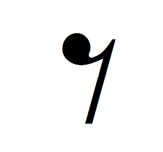

Is it also necessary to say "beat or sub-beat"? Isn't it suffice to pick "beat" or "sub-beat" and just say one of them since they both serve the same purpose here? I think the teacher is using completing a beat equally to completing a sub-beat. So for the fist rule, I believe it would have been sufficient to say: "use rests to complete the beat, before you do anything else." since we know that the rests we need have to be less than one beat in order to complete an incomplete beat. When completing a beat or a sub-beat, always put a larger note/restīefore a shorter one, and not the other way around. If the rest you need is worth less than one beat, use smaller rests toĬomplete the beat or sub-beat, before you do anything else. Faber Music (publisher), 2011.I am currently studying music theory via Īnd I can't perhaps understand the English this teacher is using while trying to explain these two rules of adding rests:
#Quaver rest manual
^ a b Music Notation: A Manual of Modern Practice, second edition, by Gardner Read (Boston: Alyn and Bacon, 1969): 98.The "old" form was taught as a manuscript variant of the printed form. The book was the standard theory manual in the UK up until at least 1975. The former shows both forms without distinction, the latter the "old" form only. ^ Rudiments and Theory of Music Associated Board of the Royal Schools of Music, London 1958.^ Examples of the older form are found in the work of English music publishers up to the 20th century, e.g., W.^ a b c History of Music Notation (1937) by C.This also applies in the case of double barlines, which demarcate musical phrases or sections, and also if a rehearsal letter occurs during the rest. If a meter or key change occurs during a multimeasure rest, the rest must be broken up as required for clarity, with the change of key and/or meter indicated between the rests. The number of whole-rest lengths for which the multimeasure rest lasts is indicated by a number printed above the musical staff (usually at the same size as the numerals in a time signature). How long exactly must a multirest be until the above method is used is largely a matter of personal taste, most publishers use ten as the changing point, however bigger and smaller changing points are used, especially in earlier music. The former system of notating multirests (deriving from Baroque notation conventions that were adapted from the old mensural rest system dating from Medieval times) draws multirests according to the picture above right until a certain amount of bar rests is reached when multirests are then drawn to the first method.As long, thick horizontal lines placed on the middle line of the staff, with serifs at both ends (see above middle picture) or as thick diagonal lines placed between the second and fourth lines of the staff (but this method is much less used than the above method although a small number of publishers use this method, it most commonly used casually in modern manuscripts), regardless of how many bars' rests it represents.

Multimeasure rests of are usually drawn in one of two ways: In instrumental parts, rests of more than one bar in the same meter and key may be indicated with a multimeasure rest (British English: multiple bar rest), showing the number of bars of rest, as shown. Seven measure multirest, notated variously The combination of rests used to mark a pause follows the same rules as for note values.The four-measure rest or longa rest are only used in long silent passages which are not divided into bars.The quarter (crotchet) rest (𝄽) may also be found as a form in older music.Each rest symbol and name corresponds with a particular note value, indicating how long the silence should last, generally as a multiplier of a measure or whole note. Rests are intervals of silence in pieces of music, marked by symbols indicating the length of the pause. A rest is a musical notation sign that indicates the absence of a sound.Įach rest symbol and name corresponds with a particular note value for length, indicating how long the silence should last.


 0 kommentar(er)
0 kommentar(er)
